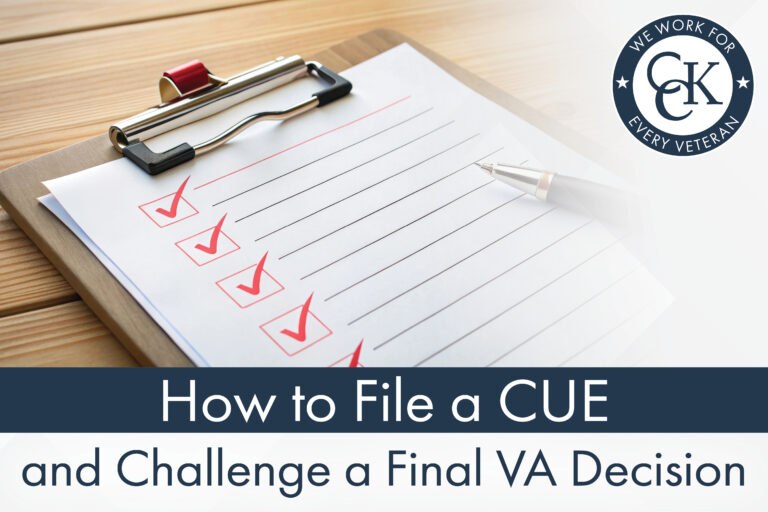How to File a CUE and Challenge a Final VA Rating

CCK Law: Our Vital Role in Veterans Law
Once a VA decision becomes final—meaning the time to appeal has passed—it can feel like the end of the road for a veteran seeking benefits. However, the law provides a limited but important exception: the ability to challenge that final decision by filing a motion based on clear and unmistakable error (CUE).
CUE motions are often misunderstood—and often misused. Not every disagreement with VA qualifies as a clear and unmistakable error. To succeed, the error must be undebatable and must have directly affected the result of the claim.
In this article, CCK Law will discuss:
- Why a veteran would file a CUE
- How veterans can file a CUE
- Key elements in a CUE filing
- And more
Why Would a Veteran File a CUE?
A successful CUE motion can result in the reversal of a prior VA ruling, potentially unlocking years of retroactive benefits. But this process is not the same as a typical appeal or supplemental claim.
It requires the veteran to show that VA made a specific legal or factual error that was both obvious and outcome-determinative at the time the decision was made.
There is no time limit for filing a CUE. So, for example, even if VA issued a decision on a veteran’s claim 20 years ago (and the veteran never appealed), then filing a CUE could hypothetically allow the veteran to challenge that decision today.
CUEs can be used for claims decisions at both the VA Regional Office level and at the Board of Veterans Appeals level.
There are certain kinds of cases that may be more likely to win a CUE because VA adjudicators often make legal or factual errors in these types of cases. One such example is a final decision in which the VA reduced a veteran’s award from 100% to a lower percentage. Another example is a final decision in which the claimed disability was related to a wound from a shell fragment, gunshot, or IED.
How Would a Veteran Go About Filing a CUE?
CUEs are filed with the Regional Office or the Board, whichever made the decision that the vet is challenging. Requests for revision based on CUE must be very clearly worded and detailed because they have what the Court calls a “pleading requirement.”

A “pleading requirement” is the term that means a person filing the CUE must thoroughly address four requirements. If they cannot address these requirements, then they cannot win their motion. These requirements are:
- The decision being challenged must be a “final decision” from the Regional Office or the Board of Veterans Appeals that was never appealed,
- When the decision was made either the correct facts were not before the adjudicator or the regulatory or statutory provisions were incorrectly applied.
- The error is “undebatable” – that is, a reasonable person would not disagree that what the VA did was incorrect.
- The error must have made a difference in the outcome of the decision. In other words, one must show that the error cost the veteran his or her benefits.
Key Elements of a Clear and Specific CUE
Requests for revision based on CUE must be extremely specific. There are a few main points that veterans should make if they are filing a CUE.
First, they must identify the decision they are attacking based on CUE. The veterans cannot say that they are alleging a CUE and not note which decision they think contains the error.
Second, the veteran must analyze why the final VA decision contains a CUE. It is helpful to cite specific evidence and laws when they are laying out their argument for CUE. It is also helpful to cite the specific legal or factual basis for the allegation.
Third, veterans should explain why they believe the outcome would have been different if the CUE had not been made. This usually involves explaining why, if the CUE did not happen, the veteran would have otherwise been granted benefits. There must be proof that reasonable minds could not disagree that the result would have been manifest differently if it were not for the error.
How Many CUEs Can a Veteran File?
The number of CUEs a veteran can file depends on the type of decision they are contesting. If they are filing a CUE with a rating decision, then they can file multiple CUEs if they believe multiple errors were made. For a rating decision, each CUE is a separate filing.
If a veteran is challenging a final decision from the Board of Veterans’ Appeals, meaning a final Board denial, all CUEs must be raised at the same time.
If the veteran believes multiple CUEs were made in a single decision, they must include them all in their initial filing. Once they have filed the request for revision, they cannot file another one based on another error. Additionally, if the veteran is denied their request for revision with a final Board decision, they cannot submit another request for revision based on CUE. In short, veterans only get one chance to file a CUE with a final Board decision.
If you are successful in challenging a past decision based on CUE, the usual rules for effective dates do not apply. Instead, your effective date will be the date you submitted the claim that contained the clear and unmistakable error, meaning the VA will retroactively pay you all the benefits you would have received from that date.
Call CCK Law Today
CCK Law has been helping veterans since 1999 get the benefits they deserve. If you need help with your VA appeal, we may be able to help you, too. Call us today at (800) 544-9144 for a free case evaluation with a member of our team.
About the Author
Share this Post
